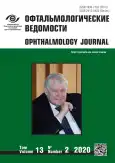Conditions for improving the effectiveness of surgical treatment of patients with chronic dacryocystitis in endonasal endoscopic procedures
- Authors: Davydov D.V.1, Маgomedov М.М.2, Маgomedova N.М.3
-
Affiliations:
- Peoples’ Friendship University of Russia
- N.I. Pirogov Russian National Research Medical University
- European Medical Center
- Issue: Vol 13, No 2 (2020)
- Pages: 15-21
- Section: Original study articles
- URL: https://journals.rcsi.science/ov/article/view/33437
- DOI: https://doi.org/10.17816/OV33437
- ID: 33437
Cite item
Abstract
Introduction. Surgical treatment of patients with chronic dacryocystitis is a complex interdisciplinary problem. Lacrimal sac can be reached externally and internally (endonasally). The effectiveness of the treatment largely depends on the results of complete diagnosis and choice of a treatment method.
Purpose. To analyze the effectiveness of surgical treatment of patients with chronic dacryocystitis in endonasal access.
Materials and methods. The study of 225 patients consisted in the analysis of two groups of patients (2015–2019) with chronic dacryocystitis: the first group (110 patients) underwent an endonasal endoscopic dacryocystorhinostomy in the form of monooperation, the second underwent endonasal endoscopic dacryocystorhinostomy with additional intranasal interventions (115 patients). All patients underwent endoscopic examination of the nasal cavity and midface multispiral computed tomography (MSCT).
Results. The results of the obtained data convincingly showed a higher efficiency of treatment in the group of patients with combined operations with the pathological processes revealed in intranasal localization in comparison with the group of monoperations.
Conclusion. According to the study data, patients with chronic dacryocystitis should undergo full ophthalmologic and endonasal diagnostics, including multispiral computed tomography-dacryocystorhinography of the middle facial zone according to the described algorithm. When detecting pathological processes hindering the standard endonasal endoscopic dacryocystorhinostomy, it is necessary to perform an expanded scope of surgical interventions which will contribute to the efficiency of treatment of patients with chronic dacryocystitis up to 91.3%.
Full Text
##article.viewOnOriginalSite##About the authors
Dmitriy V. Davydov
Peoples’ Friendship University of Russia
Author for correspondence.
Email: davydov3@yandex.ru
MD, PhD, DMedSc, Professor, Head of Department, Reconstructive Surgery Department with Ophthalmology Course
Russian Federation, MoscowМagomed М. Маgomedov
N.I. Pirogov Russian National Research Medical University
Email: magalor62@mail.ru
Professor of the Department of Otorhinolaryngology
Russian Federation, MoscowNapisat М. Маgomedova
European Medical Center
Email: Nmagomedova91@mail.ru
Nmagomedova91@mail.ru
Russian Federation, MoscowReferences
- Рождественский М.В. Причины и лечение слезотечения // Офтальмологический журнал. – 1967. – № 2. – С. 130–132. [Rozhdestvenskiy MV. Prichiny i lecheniye slezotecheniya. Oftal’mologicheskiy zhurnal. 1967;(2):130-132. (In Russ.)]
- Leong SC, Karkos PD, Burgess P, et al. A comparison of outcomes between nonlaser endoscopic endonasal and external dacryocystorhinostomy: single-center experience and a review of British trends. Am J Otolaryngol. 2010;31(1):32-37 https://doi.org/10.1016/j.amjoto.2008.09.012.
- Karim R, Ghabrial R, Lynch T, Tang B. A comparison of external and endoscopic endonasal dacryocystorhinostomy for acquired nasolacrimal duct obstruction. Clin Ophthalmol. 2011;5:979-989. https://doi.org/10.2147/OPTH.S19455.
- Кузнецов М.В. Совершенствование диагностики и эндоназальной эндоскопической хирургии при непроходимости слезоотводящих путей: Автореф. дис. ...канд. мед. наук. – М., 2004. – 13 с. [Kuznetsov MV. Sovershenstvovanie diagnostiki i ehndonazalnoj ehndoskopicheskoj khirurgii pri neprokhodimosti slezootvodyashchikh putej. [dissertation abstract] Moscow; 2004. 13 p. (In Russ.)].
- Белоглазов В.Г., Атькова Е.Л., Абдурахманов Г.А., Краховецкий Н.Н. Профилактика заращения дакриостомы после микроэндоскопической эндоназальной дакриоцисториностомии // Вестник офтальмологии. – 2013. – T. 129. – № 2. – С. 19–22. [Beloglazov VG, At’kova EL, Abdurakhmanov GA, Krakhovetskii NN. Prevention of ostial obstruction after microendoscopic endonasal dacryocystorhinostomy. Annals of ophthalmology. 2013;129(2): 19-22. (In Russ.)]
- Краховецкий Н.Н. Сравнительный анализ способов формирования дакриостомы при эндоскопической эндоназальной дакриоцисториностомии: Автореф. дис. …канд. мед. наук. – М., 2015. – 24 с. [Krakhovetskiy NN. Sravnitel’nyy analiz sposobov formirovaniya dakriostomy pri endoskopicheskoy endonazal’noy dakriotsistorinostomii. [dissertation abstract] Moscow; 2015. 24 р. (In Russ.)]. Доступно по: https://search.rsl.ru/ru/record/01005558160. Ссылка активна на 15.02.2020.
- Карпищенко С.А., Белдовская Н.Ю., Баранская С.В., Карпов А.А. Офтальмологические осложнения функциональной эндоскопической хирургии околоносовых пазух // Офтальмологические ведомости. – 2017. – Т. 10. – № 1. – С. 87–92. [Karpishchenko SA, Beldovskaya NYu, Baranskaya SV, Karpov AA. Ophthalmic comlications of functional endoscopic sinus surgery. Oftalmologičeskie vedomosti. 2017;10(1):87-92. (In Russ.)]. https://doi.org/10.17816/OV1087-92.
- Давыдов Д.В., Манакина А.Ю., Стебунов В.Э. Хронический посттравматический дакриоцистит у пациентов с посттравматическими деформациями средней зоны лица: особенности диагностики // Head and Neck / Голова и шея. Российское издание. – 2013. – № 1. – С. 47–49. [Davydov DV, Manakina AY, Stebunov VE. Chronic post-traumatic dacryocystitis in patients with post-traumatic deformations of the central zone of the face: diagnostic specifics. Head and Neck / Golova i sheja. Rossijskoe izdanie. 2013;(1):47-49. (In Russ.)]
- Привалова Е.Г., Смысленова М.В., Лежнев Д.А., Давыдов Д.В. Комплексное лучевое обследование пациентов с хроническими дакриоциститами // Радиология — практика. – 2014. – № 2. – С. 14–25. [Privalova EG, Smyslenova MV, Lezhnev DA, Davydov DV. The Comprehensive radiology examination at the patients with chronic dacryocystitis. Radiologija – praktika. 2014;(2):14-25. (In Russ.)]
- Красножен В.Н. Хирургия патологии слезоотводящих путей. – Казань, 2005. – 37 с. [Krasnozhen VN. Khirurgiya patologii slezootvodyashchikh putey. Kazan’; 2005. 37 р. (In Russ.)]
- Саад Эльдин Н.М. Анализ причин и меры предупреждения развития рецидивов после дакриориностомий: Автореф. дис. …канд. мед. наук. – М., 1998. – 27 с. [Saad El’din NM. Analiz prichin i mery preduprezhdeniya razvitiya retsidivov posle dakriorinostomiy. [dissertation abstract] Moscow; 1998. 27 р. (In Russ.)]. Доступно по: https://search.rsl.ru/ru/record/01000202560. Ссылка активна на 15.02.2020.
- Пальчун В.Т., Магомедов М.М., Абдурахманов Г.А. Эндоскопическая эндоназальная дакриоцисториностомия // Материалы Рос. научно-практич. конф. – М., 2002. – С. 247–248. [Pal’chun VT, Magomedov MM, Abdurakhmanov GA. Endoskopicheskaya endonazal’naya dakriotsistorinostomiya. (Conference proceedings) Materialy Ros. nauchno-praktich. konf. Moscow; 2002. Р. 247-248. (In Russ.)]
Supplementary files















